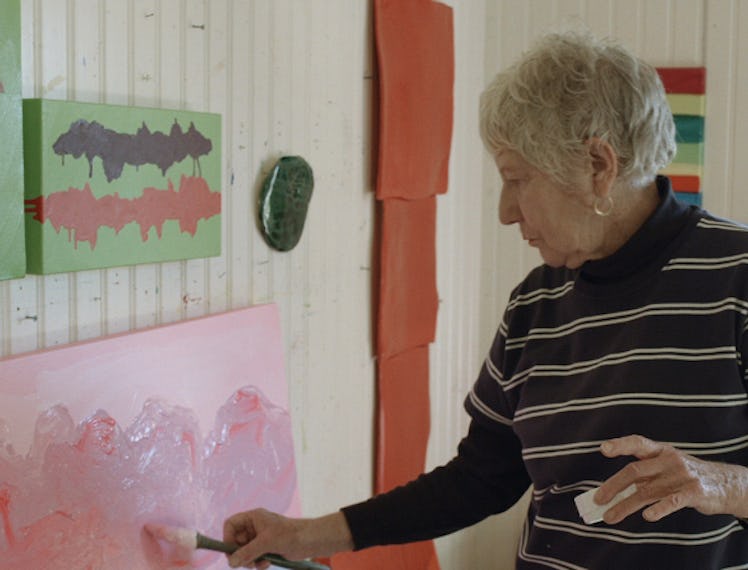A New Documentary Gives Beat Painter Mary Heilmann Her Due
Waves, Roads, & Hallucinations captures the sensibilities of the legendary abstractionist.

The abstract painter Mary Heilmann’s geometric works and visual interpretations of her life have served as inspiration for generations of artists—particularly women—since the 1960s. And today, at the age of 84, Heilmann is still hard at work. She paints often with vibrant colors, drip techniques, and malleable geometries, for a minimalist result that is slightly off-kilter. The new documentary Waves, Roads, & Hallucinations (available for streaming on July 30) from director Matt Creed chronicles the artist’s life and work through archival footage and intimate, present-day conversations, mostly taking place in the artist’s studios in Bridgehampton and Tribeca over seven years.
“It was a very intimate project,” Creed explains over the phone. “It was never more than three of us, sometimes it was just me. Mary never had anyone in her studio when she was working, and having a camera on an artist can be a very daunting and self-conscious experience.” The director and his small team kept things minimal, using a long lens to stay out of the way while shooting. “The idea was, when you watch this movie, you’re sitting there with her, and she’s telling a story. I’m just putting visuals to accompany it.”
Heilmann, a San Francisco native, is also captured on camera completing works, interpreting them to Creed, and overseeing the installation process of past exhibitions. “I related to a lot of what Mary had to say about approaching making art, which is how I approached making the film,” Creed says.
Heilmann’s work is informed by her own autobiographical story: coming of age in California against the backdrop of surf culture and the emergence of 1960s counterculture movements. At the University of California, Berkeley, she studied under Peter Voulkos, an abstract ceramist who shared her approach to art with an “attitude of antagonism and playful sarcasm”—what might be considered an “unusual” motivation for a woman at the time, Heilmann says in the documentary. She didn’t pick up painting until she moved to New York in 1968, when she broke into a cutthroat art scene dominated by male artists.
A card-carrying member of the Beat Generation, Heilmann experimented with psychedelic drugs to enhance her creative experiences and intellectual pursuits—a journey of which she speaks fondly in the film. In fact, her own hallucinations served as direct influences for paintings. “That’s a way to give basic, non-objective, color field, abstract painting some backstory ,” the painter explains, “Contextualizing it with the drug culture that I grew up in.”
A significant portion of the film contains Heilmann reflecting on her life with clarity and honesty. Loneliness, she says, and a lack of personal connection in her childhood is central to her identity as an artist. On the other hand, she realizes that great ideas are often the result of connecting with others.
“You get so much more sensitive and aware and clear when you connect with the sensibilities of other people,” Heilmann adds. “That makes getting old a positive thing: even when you’re not there anymore, you’re there.”
Waves, Roads, & Hallucinations is available to stream on AppleTV and Prime Video.